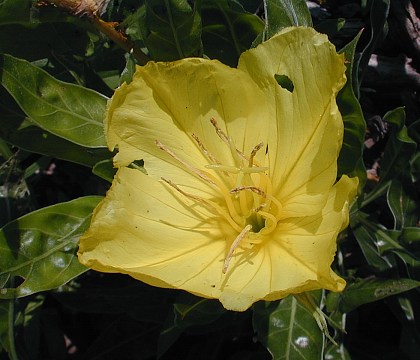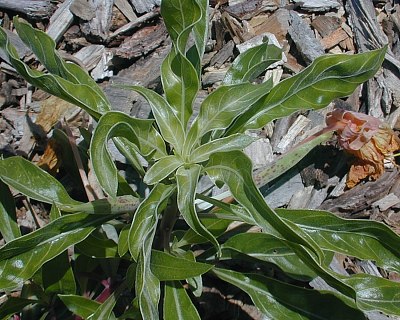Description: This herbaceous perennial plant is up to 1½' tall, and unbranched or sparingly so. The short stems are more or less erect. The alternate leaves are up to 6" long and 1" across; they are rather densely crowded along the stems. Their margins are smooth, or slightly dentate with widely spaced teeth; they often curve upward. The leaves are narrowly lanceolate or oblanceolate, with white veins; the upper surface of young leaves is often shiny. Lower leaves have petioles up to 1" long, while upper leaves are often sessile.

The large flowers
develop singly from the upper axils of the leaves. Each flower has a
winged capsule containing the ovaries that is 1½–2" long; it is located
adjacent to the leaf axil. A calyx tube from 2-6" connects the capsule
to the rest of the flower. At the apex of the calyx tube, the flower
has 4 yellow petals; it spans about 5" across. These petals are
subtended by a division of the calyx into lanceolate tips that curve
downward; these are purple-spotted. At the throat of the flower, are 8
stamens with linear anthers, and a long style with a stigma that is
cleft into a cross-like shape. These reproductive parts are yellow. The
flower buds are about 1-4" long, depending on their maturity, and quite
conspicuous. They are purple-spotted and orbicular, tapering at both
ends. The flowers open during the evening and close the following
morning, each one lasting a single day. The blooming period occurs from
early to mid-summer, and lasts about 2 months. There is a mild floral
fragrance. The seeds are irregularly shaped and crested. The root
system consists of a deep taproot. This plant reproduces by reseeding
itself.
Cultivation:
The preference is full sun, dry conditions, and lean soil that is
either rocky or sandy. Most growth occurs during the first half of the
year, afterwhich it forms seeds and becomes dormant (although it
doesn't necessarily die down). This plant will grow in more fertile
soil if it is well-drained, but has difficulty competing with taller
plants.

Range &
Habitat:
In Illinois, the native Missouri Evening Primrose has been observed in
natural
habitat in only St. Clair county, where it may be extirpated (see Distribution
Map). Habitats include hill prairies and limestone glades.
Outside of the state, this plant is also observed in dry prairies and
barrens with sparse vegetation; these habitats often have gravelly or
sandy soil. Missouri Evening Primrose is often grown in flower gardens.
Faunal Associations:
Sphinx moths pollinate the flowers while seeking nectar. Various bees
may visit the flowers to collect pollen during the early morning or
evening, but they are too small to be effective pollinators. Little
information is available about this plant's relationships to birds or
mammals.
Photographic Location:
The photographs were taken at Crystal Lake Park in Urbana, Illinois.
Comments:
Missouri Evening Primrose has striking flowers that are quite large for
the size of the plant. It can be confused with no other plant that
occurs (or used to occur) in the natural habitats of Illinois.